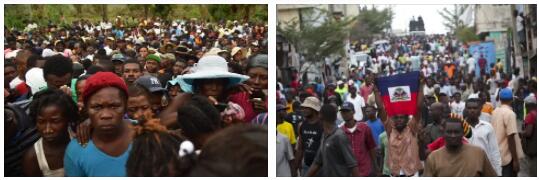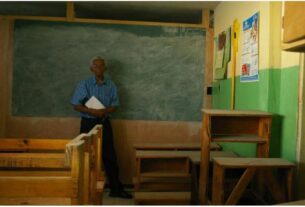A unitary profile of the literature that has flourished in the entire complex of the French-speaking territories of the Antilles will be drawn here, not presenting substantial divergences in ideas and personalities. The area therefore includes, in addition to the republic of Haiti which constitutes its political-cultural center, the two French overseas departments, Martinique and Guadeloupe, and some smaller islands, where mostly – with the official English language or Spanish – a Franco-Creole jargon prevails in the spoken language.
First black republic (1804), Haiti has not actually reached a stable democratic order up to now: the uninterrupted internal rivalries, the twenty years of the US occupation (1915-34), being at the center of the economic and political interests of France, Spain and the United States, generate all kinds of problems and delay, if they do not completely prevent the maturation of a political, national and cultural identity. Despite the generosity and courage of many intellectuals – often forced into exile in Africa, America and above all in Europe -, Haitian and more generally Antillean culture appears to be strongly conditioned by serious fractures and basic difficulties, ranging from the language problem. (French or Creole?) to that of a purely indigenous cultural definition (d ‘ voodoo. But it is undoubtedly from this painful and dissociating particularity that the fascination of this literature springs: a substantially protest literature, which on notes of drama, irony and fairy tales is told and analyzed, relentlessly and generously looking for fixed points for stability. finally autonomous politics and cultural definition.
Poetry and fiction. – According to eningbo, the French domination has clearly conditioned Haitian life and culture, to the point that only recently Creole – a basic French dialect with simplified grammar and some residues of African speech – has risen to literary dignity thanks to some intellectuals who, attempts by OA Durand (1840-1906), author of the idyll Choucoune (1884), by G. Sylvain (1866-1925) who in 1901 had published Cric? crack!, a tasty adaptation of the fables of La Fontaine, and of some other exponents of the movement of ideas oriented to the enhancement of the indigenous culture, seek the conquest of autonomous expressiveness, both linguistic and creative.
At the end of the century, around two magazines, La jeune Haïti (1895-98) and La Ronde (1898-1902), a group of writers met, almost all of them educated in Paris, who generally combine the purpose of the cult of form. to exalt the peculiar traits of their origin and land, in particular the Creole dialect (however used with mostly coloristic intentions): such as E. Vilaire (1872-1951), D. Vaval (1879-1960), F. Marcelin (1848-1917) or the more pathetic A. Innocent (1873-1960) author of Mimola (1906), considered the first folkloric novel; or like the sparkling storytellers J. Lhérisson (1873-1907) and F. Hibbert (1874-1928).
The twenty years of the American occupation (1915-34) only occasionally affected the by now deep-rooted French acculturation of the Haitian intelligentsia, indeed the cultural and ideological contrast between the two civilizations generates the sharp stiffening – which often takes on irredentist tints – of many intellectuals, who stand up in defense of their roots, valuing both the most recent traditions – the Haitian and those, linguistic and literary, of French ancestry – and the most remote, such as the Africans, distant but no less perceived.
Of the claim of African origin – who will find ample resonance in the Revue Indigène (1927-29) and later in the group Griots – is the tutelary deity ethnologist J. Price-Mars (1876-1969), who in the essays Ainsi the talks’ oncle (1928) and Formation ethnique, folklore et culture du peuple haïtien (1929) promotes a vast movement of Africanist ideas, whose basic principle is that blacks must rediscover their own ethnic and cultural roots, not aim for the assimilation of those of European or American whites. He makes persuasive reference to indigenous culture as a melting pot of autochthony and French civilization – especially in the Histoire du peuple haïtien (1953) – the historian L.-D. Bellegarde (1877-1966); a reference that in not a few poets, almost all of Parnassian training, is colored with ethnic-political ignitions: as in M. Coicou (1867-1908), who owes his fame as a patriot poet to his debut collection, Poésies nationales (1892), to his many satirical comedies, to the novel La Noire (1905), in which he denounces the colonial origin of racism, but above all to the tragic end in front of the firing squad for having participated in a conspiracy against President Nord-Alexis; in F. Burr-Reynaud (1886-1948), who joins curses for invaders to the celebration of the aborigines; as in the indigenist L. Laleau (1892-1979), who in the lyrics of Flèche au coeur (1926), Ondes courtes (1933; the two collections were republished, reunited, in 1978) and Musique nègre (1933) is the spokesperson for the lacerations caused by the plurality of traditions and the subordinate condition of the Haitian people and culture; again in E. Roumer (b.1903), whose polemical position against the Americans, moderate in Poèmes d’Haïti et de France (1925), becomes harsh in later collections, Le caïman étoilé (1963) and, in Creole, Rosaire couronne sonnets (1964).
Around the new magazine Les Griots (1938-40 and 1948-50), which inherits the claims of the Revue Indigène, some avant-garde intellectuals move towards the end of the 1930s, proposing, in addition to a radical renewal of traditional metric and thematic schemes, a new profile of a poet, who must be both a witness and an actor of the by now long-standing drama of the African populations on both sides of the Atlantic.
An important exponent of this movement of ideas, moreover quite jagged in the lines of expression – the range goes from surrealism to hermeticism, from realism to expressionism – is J. Roumain (1907-1944), founder (1934) of the Party Haitian communist and (1941) of the Bureau d’ethnographie, author of ” indigenist ” short stories and novels (La proie et l’ombre, 1930; La montagne ensorcelée, 1931; Les fantoches, 1941), racial claims (Bois d’ébène, 1945) and the vast narrative fresco Gouverneurs de la rosée (1944), which revealed it internationally.
In the same direction move C. Brouard (1902-1965), director of Les Griots and author of theoretical prose on indigenism (Pages retrouvées, 1963; Ecrit sur un ruban rose, 1965); Ph.-T. Marcelin (1904-1975), the poet of La Négresse adolescent (1932) and Lago lago (1943), the essayist of Contes et légendes d’Haïti (1967), best known for some novels written in collaboration with his brother Pierre, Canapé vert (1944), La bête de Musseau (1946), Le crayon de Dieu (1952), Tous les hommes sont fous (1980); F. Morisseau-Leroy (b.1912), who in addition to a remarkable novel, Récolte (1946) and to some collections of lyrics (Plénitude, 1940; Natif-Natal, 1949), intended to reaffirm the literary dignity of the Creole language with the comedy Anatol (1946), with the reduction from Sophocles Antigone créole (1953) and with the poetic collection Diacoute (1959); JF Brierre (b.1909), one of the most evocative voices of Haitian opera, self-exiled in Dakar, mournful but far from resigned cantor of black suffering (Black soul, 1947; Les aïeules, 1950; La nuit, 1955; Images d ‘or, 1959; Aux champs pour Occide, 1960; Découvertes, 1966; Un Noël pour Gorée, 1980; Sculptures de proue, 1983); C.-M. Saint-Aude (1912-1971), poet with a clear surrealist matrix in the collections Dialogue de mes lampes, Tabou (1941) and Déchu (1956), as well as suggestive narrator in the novel Parias (1949) and in the stories gathered in Ombres et reflets (1952) and Veillées (1956).
At the end of the Thirties, some writers feel the need to tie art more closely to life, and their voices become harsher and more uncompromising towards political oppression, which of course is also and above all social and economic oppression. Real points of reference and models for their generation and the next were R. Camille (1912-1961) and R. Depestre (b. 1926).
Camille, essayist, journalist and politician, intensely expressed in his lyrics (Assaut à la nuit, 1940; Multiple présence, 1951, but published in 1978) the humiliating condition of ” negritude ”, oppressed by atavistic poverty that in practice they nullify any tension of redemption.
Precocious poet, Depestre publishes Etincelles at nineteen; and also in 1945 he founded the avant-garde political-literary magazine La Ruche, whose almost immediate suppression would provoke a rebellion of students and intellectuals who soon, gathered the widespread discontent of every social class, spread to the whole country in open revolt against the government of dictator E. Lescot. After having actively participated in the life and initiatives of the new government of D. Estimé, due to differences with some members of the management, Depestre leaves his native land and begins a series of trips and stays that will take him first to France – where he begins his university studies. and where he publishes Végétation de clartés (1951), Traduit du Grand Large (1952) and Minerai noir (1957) -, then in Chile, in Italy and in many other countries of the European and American continent. Settled in Cuba in 1959, he remained there for twenty years as an enthusiastic supporter of the Castro regime; publishes essays (Pour la révolution pour la poésie, 1974) and composes some collections of lyrics (all printed in Paris: Journal d’un animal marin, 1962; Un arc-en-ciel pour l’occident chrétien, 1967; Poète à Cuba, 1973: the only collection translated into Italian, also in 1973). In 1978 he moved permanently to France, where alongside an intense cultural, publishing and non-fiction activity (Bonjour et adieu à la négritude, 1980) the composition of new lyrics (En état de poésie, 1980), the new draft (1979) of a novel, Le mât de cocagne (1974), and some short stories from 1973 (Alléluia pour une femme-jardin, 1981), the evocative narrative fresco Hadrienne dans tous mes rêves (1988; trad. it., 1991); to which the original Eros dans un train chinois was added in 1990.
Among Camille’s peers, and on the same ideological line, we must remember at least R. Bélance (b.1915), author of Luminaire (1941), Survivances (1944), Pour célébrerabbsence (1944), Epaule d’ombre (1945); and the Guadalupeans P. Niger (b. 1917), effective evocator of an African ancestral past, which rises to the passionate connotation of a lost Eden; and G. Tirolien (b.1917) who, revealing himself with Prière d’un petit enfant nègre (1947), attempted in subsequent collections (included in the volume Balles d’or, of 1961) to overcome the strictly racial concept of ” negritude ” in the direction of a broader evaluation of the single individual.
The turning point in Haitian literature by the strong personality of these authors was facilitated by factors of various kinds. The progressive disintegration of colonial ideology throughout the world greatly strengthens the awareness that only the acquisition of racial and cultural identity, a principle already proclaimed and defended as a primary necessity by scholars and publicists of Haitian origin, can bring about a radical renewal. hoped for by all the new intellectual and political forces genuinely interested in a new deal socio-political, economic and cultural of the country. The problem, thanks above all to the numerous political exiles scattered throughout the globe, crosses narrow national borders and finds decisive support in extra-island circles, in particular in the most enlightened circles of the Parisian intelligentsia, already sensitized to the phenomenon of African cultures of French expression: and at least one must remember the important essay-preface written by J.-P. Sartre for the anthology of Franco-African poets edited by LS Senghor (1948); the passionate debates that animated the three European conferences on négritude (1956, 1959 and 1967) and the Algiers conference-festival (1969). Moreover, having traced the components of its own physiognomy, Haitian literature could now recognize roots, suggestions and above all models in other black authors already internationally established, such as the Senegalese Senghor and the Martinican A. Césaire.
These new ferments of ideas find numerous and varied agglomerations in avant-garde groups. Three literary movements were born in 1960, which would gather the best forces of Haitian culture: the Samba group, which the following year re-merged as Haïti littéraire, from the name of the magazine that was its spokesperson; Régénération du Nord-Ouest d’Haïti, with the periodical Le petit samedi soir ; and Hounguénickon – ritual name of the character in ceremonies voodoo sings the first song -, leaning against the newspaper Le Nouvelliste. The first group includes, among others, R. Philoctète (b.1932), the aforementioned F. Morisseau Leroy, the imaginative painter Davertige (pseudon. Of V. Denis, b.1940), surrealist-inspired lyricist (Idem et autres poèmes, published in Haiti in 1962 and in Paris in 1964); and A. Phelps (b.1928). Founder and animator of the second group is L.-M. Benoit Pierre (b. 1939), known under the pseudonym Dieudonné Fardin; while G. Campfort (b.1938), author of two valuable lyric collections, Eaux (1966) and Clés (1970), is considered the leader of the third group, the least ideologically and stylistically compact, as it is made up of personalities united above all by the intent to celebrate the beauties and traditions of the country.
After a debut dominated by the great French symbolist poetry (Saison des hommes, 1960; Margha, 1961; Les tambours du soleil, 1962; Promesse, 1963), Philoctète progressively freed himself from it, arriving at autonomous expressive modules in which the hoarding of European models it makes the contents inspired by Haitian life and traditions rise suggestively (Ces îles qui marchent, 1969; Et caetera, 1974). Author of the science fiction novel Le huitième jour (1973), Philoctète’s fluid vein unfolds in some plays.
Persecuted and imprisoned as the founder and editor of Sémences magazine (1962), Phelps is forced into exile in Canada, where he soon becomes a respected radio and television journalist. The first collections of lyrics (Présence, 1961; Eclats de silence, 1962), strongly characterized by surrealist and symbolist echoes, are followed by a substantial production, appreciable for formal and content autonomy, both narrative (Moinsinfini, 1973; Et moi je suis une île, 1973; Mémoire en colin-maillard, 1976; Motifs pour le temps saisonnier, 1976) and lyrical (La belière caraïbe, 1980).
Ambitiously aimed at the realization of a ” total ” work, in which the main literary genres come together, is perhaps the most original movement in the history of Haitian culture, Spiralisme ; which, among other things, revisits some research tools typical of French structuralism and requires the active, indeed co-creative, involvement of the reader. Founded in 1965 by Philoctète, who moved away from Haïti littéraire, it has two young people as prominent exponents: F. Etienne (b.1936), poet (Au fil du temps, 1965; Les chevaux de avant-jour, 1967) and novelist (Mûr à crever, 1968; Dézafi, in Creole, 1975), which attempts the ” total ” work(1972); and J.-C. Fignolé (b.1941), essayist (Oswald Durand, 1968; Etzer Vilaire, ce méconnu, 1970; Pour une poésie de authentique et du solidire, 1974), poet (Prose pour un homme seul ; Fantasmes) and novelist (Les possedés de la pleine lune, 1987; Aube tranquille, 1990).
A similar radical renewal of literary form in the fusion of multiple genres proposes the Pluréalisme, movement founded in 1973 by G. Dougé (n. 1923), author of poems gathered in which – particularly in Pollen (1971) – tries to approach and exploit some modules of audiovisual communication to adapt the traditional structure of the book to the new times.
The ferments of ideas and the numerous literary currents that animated Haitian cultural life in the sixties and seventies have their roots, as well as in the aspiration to an indigenous originality, in a more or less conscious resistance to the dictatorial regime established, in that which was the first ” black republic ” in the world, by the Duvaliers. Censorship and violent repression hit political dissidents and those exponents of culture who do not want or are unable to conform, and cannot opt for exile.
Find death in an attempted insurrection J.-S. Alexis (1922-1962), the most interesting and gifted narrator of the twentieth century, who, after a remarkable artistic eve – opened by Le nègre masqué (1933), a story centered on racial prejudices and the conflict of cultures, and concluded by the novel historian Vie de Toussaint Louverture (1949) – manages to blend poetic accents, imaginative language and heated political and social issues in the triptych of novels Compère Général Soleil (1955), Les arbres musiciens (1957) and l’Espace d’un cillement (1959); and he will further approach the forms of oral literature with the stories of Romancero aux étoiles (1960). Even more his figure emerges in the panorama of Antillan prose fiction as the genre is not the most popular and, unlike opera, it has not generally had lovers whose fame has managed to cross the narrow borders of the country.
The long and very heavy tyranny of the Duvaliers crushes, disperses, homologates many of the cultural forces; but despite the cruel punitive expeditions of the tontons-macoutes, the strict censorship and the painful, massive diaspora, Haitian intellectual life is raging in clandestinity or in countries chosen as refuge by those forced into exile. Thus some narrators of the new generations come to mature contents of great socio-political commitment and personal narrative structures, aiming at protest or at least at a testimony immune from intellectualistic or pietistic yielding, whose core is made up of problems, aspirations, hopes and pains of their own land or, more generally, of all black populations.
And it will be no coincidence that the most interesting and incisive personalities of these decades also work in other fields of culture and science: such as R. Dorsinville (1911-1990), poet (Pour célébrer la terre, 1955; Le grand devoir, 1962)), ethnologist (Dans un monde de dieux, 1970), who arrived late but happily at the narrative, in contact with the reality of some West African countries (Senegal, Liberia, Ivory Coast), where he had gradually chosen to live and to act, and which offer him vast material for his remarkable novels: Kimby (1974), L’Afrique des rois (1975), Un homme en trois morceaux (1975; trad it., 1977), Mourir pour Haïti (1980), Renaître à Dendé (1980); or like the Martinican F. Fanon (1925-1961), sociologist and psychiatrist, pupil and friend of Césaire, politically committed in Algeria and Tunisia to denounce in his essays-accounts the irreversible damage caused by colonialism in the depths of the psyche of oppressed peoples and to indicate possible ways for their recovery (Les damnés de la terre, 1951; Peau noire, masques blancs, 1952; L’an V de la révolution algérienne, 1959; Pour la révolution africaine, 1964); or as J. Métellus (b.1937), scholar of mathematics and linguistics, neurologist in Paris, author of some valuable collections of lyrics in which he celebrates the splendors and miseries of the homeland (Au pipirite chantant, 1976; Voyance, 1985), and two novels of high poetic suggestion (Jacmel au crépuscule, 1981; La famille Vortex, 1982), but more recently (1983) arrived at an unusual, radical detachment from the homeland with a novel, Une eau forte, set in Switzerland; or above all the Martinique E. Glissant (b.1928), poet (Un champ d’îles, 1953; Terre inquiète, 1954; Les Indes, 1956; Poèmes, 1965; Boises, 1979; Pays revé pays réel, 1985), playwright (Monsieur Toussaint, 1961) and novelist of considerable depth (La lézarde, 1958, Renaudon prize; Le quatrième siècle, 1964; Malemort, 1975; La case du commandeur, 1981), as well as essayist (Soleil de la conscience, 1955; L’intention poétique, 1969; Le discours antillais, 1981) promoter of an interesting linguistic experimentalism, consisting of an expressive amalgamation of French and Creole.
Among the narrators of the most recent generation – almost all characterized by a considerable charge of ideological commitment accompanied by a varied and interesting range of stylistic and structural solutions – at least the following should be mentioned: J.-C. Charles (b. 1949), author, as well as the essay De si jolies petites plages (1982), the novels Bamboula Bamboche (1984) and above all a trilogy of which the first two volumes have been published, Manhattan blues (1986) and Ferdinand je suis à Paris (1987); G. Victor (b. 1958), amusing and yet bitter descriptor of social realities in d’Albert Buron ou profil d’une Elite (1988), Sonson Pipirite. Profil d’un homme du peuple (1988), and in Clair de Manbo (1990); and S. Péan (b. 1960), author of La plage des songes et autres récits d’exil (1988).



